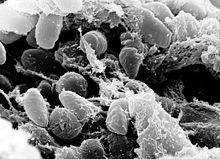Yersinia pestis
Artikel ini sedang dikembangkan sehingga isinya mungkin kurang lengkap atau belum diwikifikasi. Mohon untuk sementara jangan menyunting halaman ini untuk menghindari konflik penyuntingan.
Pesan ini dapat dihapus jika halaman ini sudah tidak disunting dalam beberapa jam. Jika Anda adalah penyunting yang menambahkan templat ini, harap diingat untuk menghapusnya setelah selesai atau menggantikannya dengan {{Under construction}} di antara masa-masa menyunting Anda.
|
Yersinia pestis (formerly Pasteurella pestis) is a gram-negative, non-motile, rod-shaped, coccobacillus bacterium, without spores. It is a facultative anaerobic organism that can infect humans via the Oriental rat flea (Xenopsylla cheopis).[1] It causes the disease plague, which takes three main forms: pneumonic, septicemic, and bubonic. There may be evidence suggesting Y. pestis originated in Europe in the Cucuteni–Trypillia culture instead of the more commonly held Asia theory.[2]
| Yersinia pestis | |
|---|---|

| |
| A scanning electron micrograph depicting a mass of Yersinia pestis bacteria in the foregut of an infected flea | |
| Klasifikasi ilmiah | |
| Takson tak dikenal (perbaiki): | Yersinia |
| Spesies: | Template:Taxonomy/YersiniaY. pestis
|
| Nama binomial | |
| Template:Taxonomy/YersiniaYersinia pestis (Lehmann & Neumann, 1896)
van Loghem, 1944 | |
| Sinonim | |
| |
Y. pestis was discovered in 1894 by Alexandre Yersin, a Swiss/French physician and bacteriologist from the Pasteur Institute, during an epidemic of the plague in Hong Kong.[3] Yersin was a member of the Pasteur school of thought. Kitasato Shibasaburō, a Japanese bacteriologist who practised Koch's methodology, was also engaged at the time in finding the causative agent of the plague.[4] However, Yersin actually linked plague with Y. pestis. Formerly named Pasteurella pestis, the organism was renamed Yersinia pestis in 1944.
Every year, thousands of cases of the plague are still reported to the World Health Organization, although with proper antibiotic treatment, the prognosis for victims is now much better. A five- to six-fold increase in cases occurred in Asia during the time of the Vietnam War, possibly due to the disruption of ecosystems and closer proximity between people and animals. The plague is now commonly found in sub-Saharan Africa and Madagascar, areas that now account for over 95% of reported cases. The plague also has a detrimental effect on nonhuman mammals;[5] in the United States, these include the black-tailed prairie dog and the endangered black-footed ferret.
Peran dalam Kematian Hitam
Pada 2000, Didier Raoult dan rekan menemukan DNA Y. pestis setelah melakukan "PCR bunuh diri" pada organ pulp gigi dari kuburan plak abad ke-14 di Montpellier.[6]
Sebuah riset yang dilakukan oleh periset internasional pada Oktober 2010 mengkonfirmasi bahwa Y. pestis adalah penyebab Kematian Hitam dan epidemik berikutnya pada benua Eropa selama periode 400 tahun. Tim tersebut DNA kuno dan protein yang diambil dari jasad korban plak yang dikubur di Hereford, Inggris, di Saint-Laurent-de-la-Cabrerisse di Prancis, dan Bergen op Zoom di Belanda untuk mengidentifikasi patogen.
Keluarga Yersinia Pestis
Yersinia pestis sebelumnya telah diklasifikasikan dalam keluarga Pasteurellaceae, tetapi berdasarkan kesamaan dengan Escherichia coli (E. coli), maka Yersinia grup reclassified sebagai anggota dari keluarga Enterobacteriaceae.
Walaupun terdapat 11 nama spesies dalam genus Yersinia, hanya tiga patogen yang dianggap penting bagi manusia:
- Yersinia pestis
- Yersinia pseudotuberculosis
- Yersinia enterocolitica.
Yersinia pseudotuberculosis adalah yang paling dekat dengan genetika Yersinia pestis, tetapi dapat dibedakan dari Yersinia pestis oleh gejala-gejala itu penyebab dan hasil uji laboratorium. Baik bakteri ini sering menjangkiti manusia, kontras ke Yersinia enterocolitica, yang menyumbang 1 sampai 3 persen dari kasus diare yang disebabkan oleh bakteri.
Yersinia Pestis di Binatang
Yersinia pestis paling sering ditemukan pada tikus, tetapi kadang-kadang dalam hewan lainnya, seperti:
- Tikus (Mice)(rat)
- Tupai
- Kutu
- Kucing
- Anjing
- Tikus kayu
- Chipmunks.
Catatan
- ^ Ryan KJ, Ray CG, ed. (2004). Sherris Medical Microbiology (edisi ke-4th). McGraw Hill. hlm. 484–488. ISBN 978-0-8385-8529-0.
- ^ Rascovan, Nicolás; Sjögren, Karl-Göran; Kristiansen, Kristian; Nielsen, Rasmus; Willerslev, Eske; Desnues, Christelle; Rasmussen, Simon (2019). "Emergence and Spread of Basal Lineages of Yersinia pestis during the Neolithic Decline". Cell. 176 (1–2): 295–305.e10. doi:10.1016/j.cell.2018.11.005 . PMID 30528431.
- ^ Bockemühl J (1994). "100 years after the discovery of the plague-causing agent – importance and veneration of Alexandre Yersin in Vietnam today". Immun Infekt. 22 (#2): 72–75. PMID 7959865.
- ^ Howard-Jones N (1973). "Was Kitasato Shibasaburō the discoverer of the plague bacillus?". Perspect Biol Med. 16 (#2): 292–307. doi:10.1353/pbm.1973.0034. PMID 4570035.
- ^ CDC, "The Plague", Centers for Disease Control and Prevention, Oct. 2017 Artikel ini memuat teks dari sumber tersebut, yang berada dalam ranah publik.
- ^ Drancourt M, Aboudharam G, Signolidagger M, Dutourdagger O, Raoult D. (2002). "Detection of 400-year-old Yersinia pestis DNA in human dental pulp: An ory of plague". Microbes Infect. 4 (1): 105–9. doi:10.1016/S1286-4579(01)01515-5. PMID 11825781.